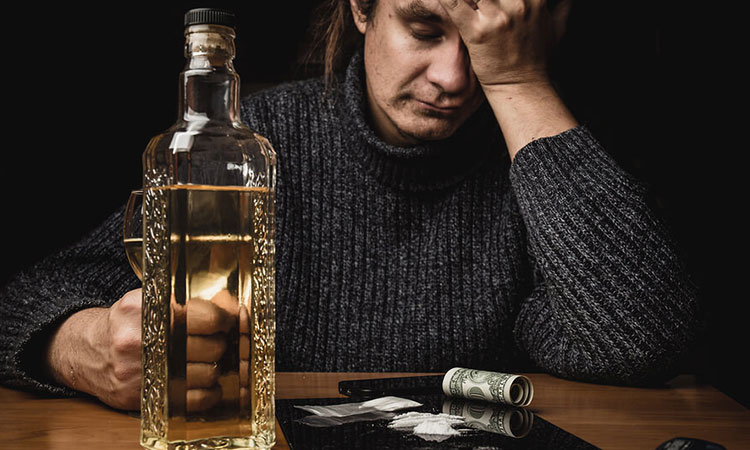
Cocaine and Alcohol – Cocaine and alcohol are frequently consumed together – people are sometimes seeking an enhanced effect, and other times, alcohol is used to help reduce the symptoms of a cocaine comedown. In either case, using cocaine and alcohol together can be even more dangerous than when abusing either drug alone.
Alcohol is a central nervous system (CNS) depressant, meaning it slows activity in the brain and body. Alcohol consumption, however, results in a huge surge of dopamine, a chemical that is associated with feelings of euphoria. It is this intense feeling of well-being that, at least at first, masks alcohol’s depressant effects.
Cocaine, on the other hand, is a CNS stimulant, meaning that it increases, rather than suppresses activity in the body. Mixing cocaine and alcohol, therefore, results in a sort of conflict of interests, so to speak, from the brain and body’s perspective.
Some Combined Side Effects
✔ Breathing Problems
✔ Rapid heart rate
✔ Cognitive impairment
✔ Increased blood pressure
✔ Impaired coordination and motor function
✔ Heart palpitations Cerebral infarction (death of blood vessels and blood tissue)
✔ Brain aneurysm
✔ Stroke
✔ Brain damage
✔ Coma
✔ Death
Cocaethylene – An Unexpected By-Product
Cocaethylene is a chemical that is formed as the byproduct of the combined use of cocaine and alcohol metabolized by the liver. In fact, cocaethylene is the only known example of the development of a third drug in the human body after the consumption of two others.
Cocaethylene is toxic in the liver, has a longer duration of action than cocaine, and is also thought responsible for many cardiac arrests among younger people in their 20s and 30’s.
But in fact, very little is known about the drug and its potential threat to users, other than it may be even more toxic to the heart, possibly carrying a much higher risk of sudden death.
Where Does Cocaine Come From?
The purest form of cocaine, cocaine hydrochloride, is a substance derived from the coca plant native to South America. While the coca leaf itself has stimulating effects, it is this powerful chemical isolated from the plant that makes cocaine both desirable as a drug and very dangerous.
Types of Cocaine
- Pure cocaine is almost never seen on the street, but can rarely be found up to a 98% purity. Most of the time, however, it is less than 40% pure and is cut with additives such as caffeine, sugar, and other drugs. Cocaine often comes in powder form and with colors ranging from whitish-grayish (chalk.) Cocaine has effects that make the user feel happy, energetic, and talkative. Cocaine use results in a relatively short high, however, and even inexperienced or first-time users are not likely to feel its effects for more than an hour.
- Freebase cocaine is cocaine that is nearly free of the drug’s hydrochloride additive. Freebase cocaine is the result of the conversion of powder cocaine to cocaine sulfate. This drug is therefore nearly 100% pure and highly dangerous to use. Crack cocaine can also be yellowish in color, is wax-like, and usually smoked in a pipe.
- Crack is a combination of cocaine and other chemicals such as ammonia, ether, or baking soda, and often has stronger effects compared to refined, powdered cocaine. It also has a greater potential for addiction.
Methods of Use
Cocaine powder is most commonly aspirated or “snorted.” However, some users inject it. Snorting cocaine can lead to frequent nosebleeds, infections, and irreversible damage to the nasal septum and surrounding tissues.
Injecting cocaine into a blood vessel or under the skin can result in damage to both the veins and skin, including sores, abscesses, and infections.
Smoking cocaine increases the risk of bronchitis and pneumonia.
Alcohol Addiction
Alcohol addiction, however, even without the presence of other drug use can be very destructive and have devasting consequences. It can result in mental and health problems, legal issues, and family/social conflicts.
Alcohol addiction is characterized by the excessive use of alcohol, tolerance, and dependency. Tolerance is a term to describe how the body becomes desensitized to alcohol use, and therefore, over time, more is needed to achieve intoxication.
Dependency occurs when the brain becomes accustomed to the drug’s presence and can no longer function “normally” without it. When the drinker tries to drastically cut back or quit altogether, unpleasant withdrawal effects result.
Treatment for Alcoholism and Cocaine Abuse
When someone regularly uses alcohol and cocaine together, this is known as polysubstance abuse – a condition that is more complex than addiction to either substance is alone.
Treatment for polysubstance abuse requires long-term therapy and a comprehensive approach that also includes counseling and group support. Ideally, polysubstance abusers should undergo a residential stay in our addiction treatment center for a minimum of 30 days. For those who need more flexibility, however, intensive outpatient care is also available.
After professional treatment has been completed, support groups can be incredibly useful for maintaining long-term abstinence, as is ongoing treatments such as psychiatric services and counseling. Also, after discharge from treatment, clients can still participate in our aftercare program and alumni activities.
If you or your loved one is suffering from substance abuse, please seek help as soon as possible.